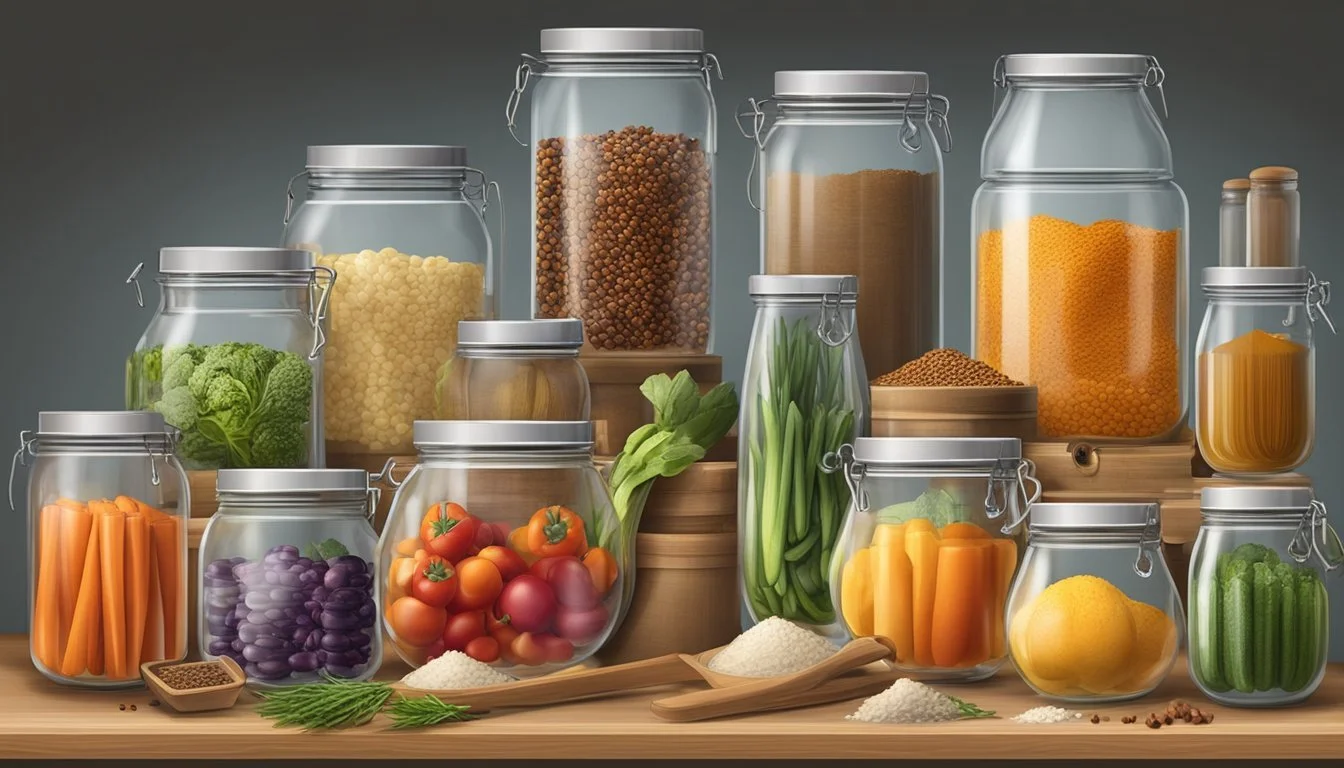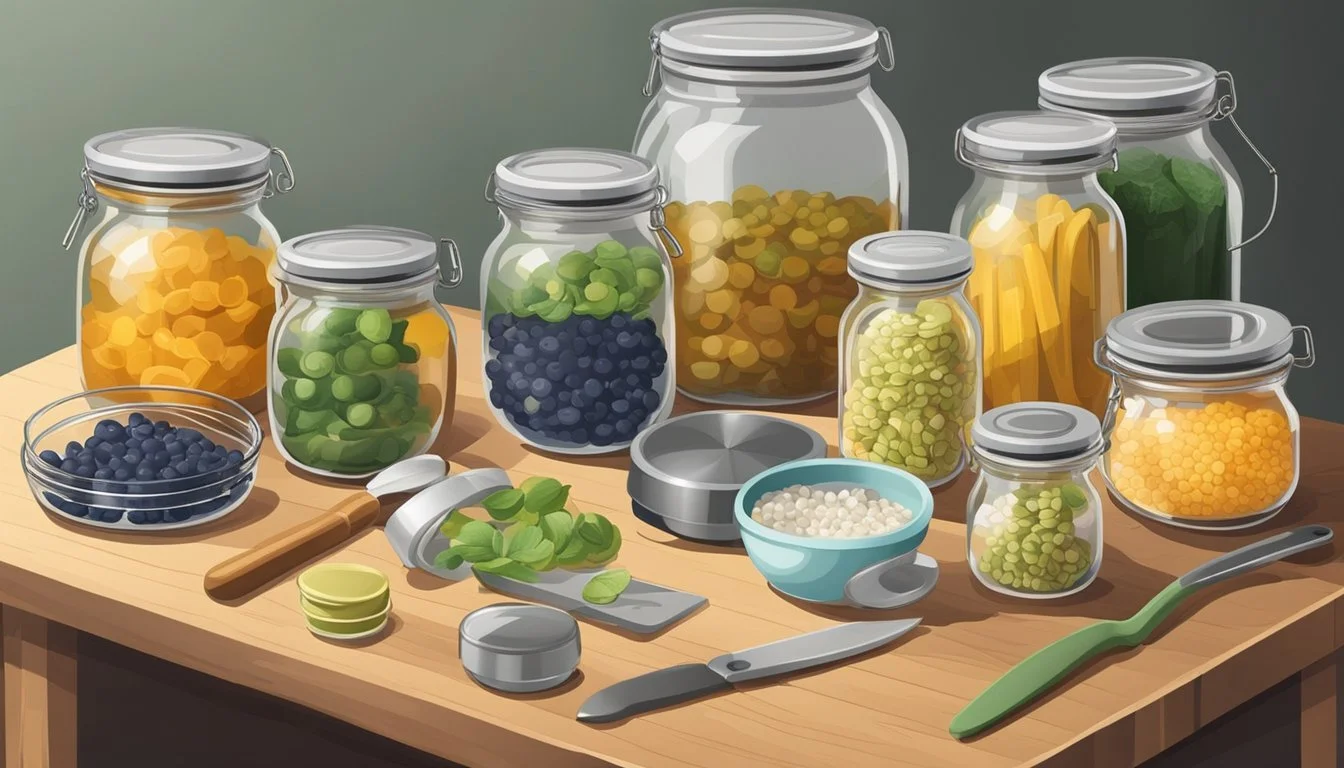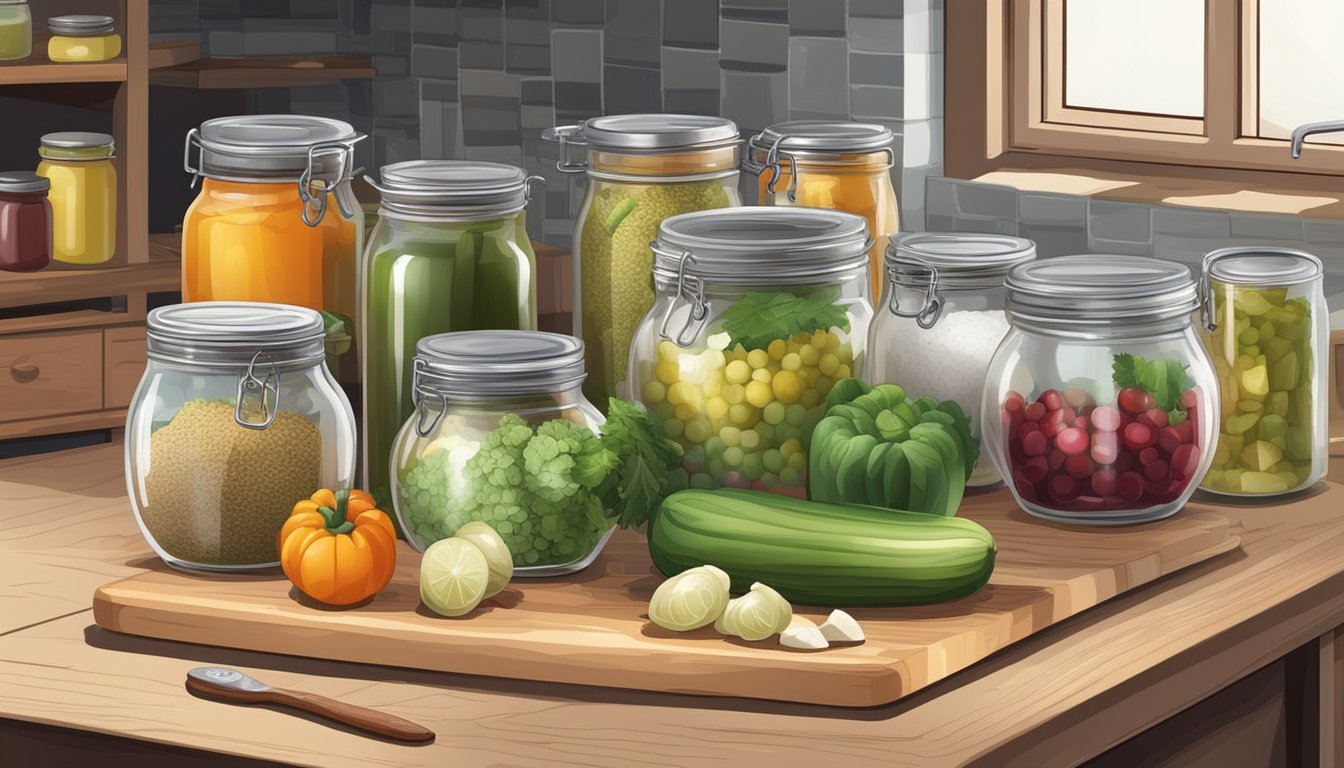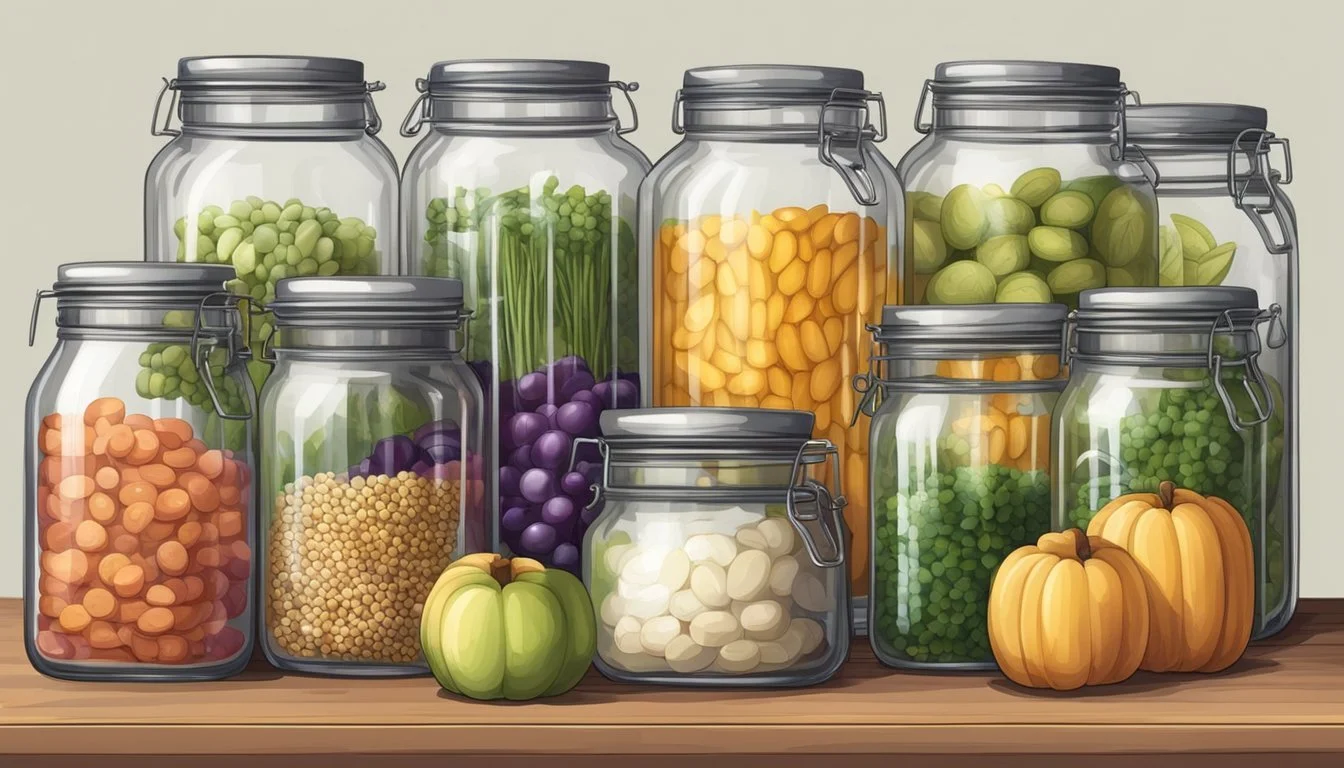Equipment List for Fermenting Food at Home
Essential Tools for Beginners
Fermenting food at home has surged in popularity as individuals seek to create their own probiotic-rich foods and reduce food waste. This process of lacto-fermentation, which relies on natural bacteria to preserve and flavor various foods, requires specific tools and environments. The right equipment can simplify the process, ensure safety, and improve the quality of the final product.
For newcomers to fermentation, understanding the essential tools is a pivotal first step. A scale is vital for precise ingredient measurement, ensuring the correct ratio of salt to vegetables, which is crucial for successful fermentation. Canning jars serve as the basic containers for small-batch fermentation, while air locks fitted on top of these jars allow gas to escape without letting outside air contaminate the ferment. Fermentation weights keep the food submerged in brine, an anaerobic environment necessary for proper fermentation to occur. Advanced enthusiasts may also utilize fermentation crocks, which are designed specifically for larger batches and provide an ideal setting for fermentation.
Monitoring tools like pH strips or meters are indispensable for ensuring the ferment is within the safe acidity range, typically a pH of 4.6 or lower, which inhibits unwanted bacterial growth. Glass bottles can be used for storing ferments like kombucha or kefir and controlling carbonation. These instruments, when used correctly, help fermenters of all levels create delicious and healthful foods at home.
Fundamentals of Home Fermenting
Home fermentation harnesses the power of natural processes to transform ingredients into flavorful, nutrient-rich foods. Employing simple tools and understanding the microbial interactions enable one to start this journey at home.
Understanding the Fermentation Process
Fermentation is the metabolic process by which natural bacteria and yeast convert carbohydrates into alcohol or organic acids under anaerobic conditions, carbon dioxide is a byproduct.
Lactic acid is commonly produced during the fermentation of food, which acts as a natural preservative and can give foods their distinctive tang. It's essential to maintain a clean environment and use quality ingredients to achieve successful fermentation at home.
Proper fermentation conditions encourage the growth of probiotics, beneficial microbes that contribute to gut health.
Key Components of Fermentation:
Microbes: Bacteria and yeast initiate the process.
Anaerobic Environment: Fermentation occurs in the absence of oxygen.
Temperature: A moderate, stable temperature promotes optimal microbial activity.
Time: The process can range from days to months, depending on the desired outcome.
Benefits of Fermented Foods
Fermented food offers a variety of health benefits primarily due to the presence of probiotics. These beneficial bacteria help with digestion and can improve the body's ability to absorb nutrients, increasing their bioavailability.
Moreover, fermented foods (What wine goes well with fermented foods?) often act as a digestive aid, introducing helpful microbes that support a balanced gut microbiome. Regular consumption can lead to an enhancement in overall digestive health.
In addition to their health benefits, fermented foods are revered for their complex flavors and long shelf life.
Advantages of Consuming Fermented Foods:
Digestion Support: Fermented foods introduce probiotics that aid in digestion.
Nutrient Absorption: Fermentation can increase nutrient bioavailability.
Gut Health: The probiotics within help maintain a balanced gut microbiome.
Flavor and Preservation: Fermentation can enhance flavor profiles and food preservation.
Fermentation Equipment Basics
When embarking on home fermentation, it is crucial to have the right equipment to ensure successful and safe results. The foundation of home fermentation involves a selection of suitable glass jars, weights, airlocks, and crocks, each playing a pivotal role in the process.
Selecting Proper Jars
Jars are the quintessential vessel for many fermentation projects. Mason jars are highly recommended due to their durability, wide availability, and the airtight seal they provide when closed.
Glass is preferable as it does not react with the acidic contents of fermentation. It’s essential to choose jars of various sizes to accommodate different ferment quantities.
Choosing Your Weights and Airlocks
Weights are necessary to keep the fermenting food submerged in brine, thus preventing mold and bacterial growth. They come in glass, ceramic, or food-grade plastic.
Airlocks fit onto fermentation jars and allow gases produced during fermentation such as carbon dioxide to escape while preventing outside air from entering. This system reduces the risk of contamination and off-flavors.
The Role of Crocks in Fermentation
A fermentation crock is traditionally used for larger batches. It's a stoneware pot designed to hold a substantial amount of produce for fermenting.
A good quality crock is heavy and thick-walled, which aids in maintaining a stable temperature during the fermentation process. Most come with weights and a water-sealing system that acts like an airlock.
Essential Ingredients and Additives
When fermenting foods at home, the right ingredients and additives ensure success and safety. The type of salt, water quality, and choice of starter cultures are critical factors that can significantly affect fermentation.
Salts and Their Functions
Sea Salt: (how long does sea salt last?) A common choice for fermentation, sea salt contains trace minerals and is typically unrefined. It is preferred over table salt, which often contains anti-caking agents and iodine that can hinder the process.
Pickling Salt: Also known as canning salt, pickling salt is pure granulated salt without additives. Its fine grain allows for even distribution, ensuring a consistent salinity level, which is important for controlling the growth of desirable lactobacillus bacteria while inhibiting harmful pathogens.
Functions of Salt in Fermentation:
Inhibits the growth of undesirable microorganisms.
Helps to maintain the crunch and texture of the ferment.
Works as a flavor enhancer.
Draws out water from ingredients to create a brine where bacteria can thrive.
Water Quality Considerations
Filtered Water: Chlorinated tap water can inhibit fermentation, so it's preferable to use filtered water, which has been purified to remove chlorine and other chemicals. Its neutral quality doesn't interfere with the microbial activity that is essential for a successful ferment.
Importance of Water Quality:
Ensures the proliferation of lactobacillus and other beneficial bacteria.
Helps to prevent the introduction of chemicals that may disrupt the fermentation.
Preserve the natural flavor of the ingredients.
Starter Cultures and Microbial Agents
Lactobacillus Bacteria: This is the main driver of lactic acid fermentation, commonly found in yogurt, kefir, and other fermented products. Starter cultures containing lactobacillus bacteria can be used to kickstart things, especially in vegetable ferments.
Using Starter Cultures:
Can help control the process by introducing a known and consistent microbial population.
Reduces the chances of spoilage by outcompeting unwanted bacteria from the start.
Microbial Agents: While many ferments rely on naturally occurring bacteria present on the surface of vegetables, using a starter culture ensures a reliable ferment, particularly for beginners or when fermenting in less-than-ideal conditions.
Preparation Techniques
Successful fermentation at home begins with good preparation. To ensure safety and quality, one must focus on three critical steps: proper cleaning and sanitization, meticulous cutting and preparing of vegetables, and accurate measuring and mixing of solutions.
Cleaning and Sanitization of Fermentation Equipment
Before starting, all equipment should be thoroughly cleaned. Use hot sudsy water to wash containers, whether plastic, glass carboys, or stainless steel followed by a rinse with hot water to remove soap residue. Sanitization can be achieved using a solution of water and food-safe sanitizer or bleach, ensuring that all surfaces are free from harmful bacteria. For hard-to-reach areas, a bottle brush may be needed.
Equipment to Clean:
Fermentation weights
Bottles
pH meter probes
Cutting and Preparing Vegetables
Vegetables should be washed and then cut to a uniform size for even fermentation. A scale can be utilized to measure ingredients accurately, and it's essential to follow the recipe closely for the amount of salt required to create the brine.
Glass weights are often used to keep the fermenting vegetables submerged in the brine, which is crucial for an anaerobic fermentation environment.
Preparation steps for Fermented Vegetables:
Wash vegetables thoroughly.
Chop or slice to the desired size.
Weigh vegetables on a scale for precise brine ratios.
Measuring and Mixing Solutions
When preparing brine, use a scale for accurate salt measurements and mix until fully dissolved. The specific gravity of the brine can be essential, so some recipes may call for measuring with a hydrometer.
Additionally, monitoring the pH of the ferment with pH strips or a meter is vital, as fermentation needs to occur in an acidic environment, typically with a pH below 4.6, for food safety.
Solution Preparation Essentials:
Scale: For exact salt and water ratios.
pH Strips/Meter: To ensure the fermenting environment is appropriately acidic.
Fermentation Recipes
In this section, you'll discover some classic recipes to kickstart your home fermentation journey. These recipes range from tangy sauerkraut (how long does sauerkraut last?) to spicy kimchi (how long does kimchi last?), along with the irresistible crunch of pickles and probiotic-rich fermented beverages like kombucha and kefir
Most fermentation recipes are experimented with and added to over time to tailor to an individual's preference. But those below serve as a good base for experimentation with flavors and ingredients, allowing the fermenter to personalize their homemade ferments.
Sauerkraut and Its Variations
Sauerkraut, a traditional German ferment made from cabbage, is simple yet versatile. Start with:
Cabbage: A large head of cabbage thinly sliced.
Salt: Preferably sea salt, approximately 1.5 teaspoons per pound of cabbage.
Massage salt into the cabbage to release its natural juices.
Pack tightly into a canning jar, ensuring the cabbage is submerged under the brine.
Once fermented, sauerkraut can be enjoyed in its classic form or altered by adding:
Caraway seeds (how long do caraway seeds last?): For an earthy flavor.
Apples: For a sweet twist.
Kimchi and Spicy Ferments
Kimchi, Korea’s national dish, is a spicy and vibrant ferment:
Napa cabbage and Korean radishes are the main vegetables.
Gochugaru (Korean red pepper flakes(how long do red pepper flakes last?) and fish sauce (how long does fish sauce last?) for depth and spice.
Prepare the vegetables by chopping and seasoning them with salt.
Add a flavorful paste made from a blend of garlic, ginger, sugar, and gochugaru.
Ferment the mixture in a fermentation kit or jar at room temperature before transferring it to the refrigerator to slow the fermentation.
Pickles and Brined Delights
Pickles are synonymous with fermentation:
Cucumbers: Choose fresh, firm cucumbers for the crunch.
Brine: Create a brine with water and salt in a ratio of 2 tablespoons of salt per quart of water.
Add spices like dill, mustard seeds (how long do mustard seeds last?), and garlic cloves to the jar.
Submerge cucumbers in brine and let them ferment until they reach the desired sourness.
Beverage Ferments: Kombucha and Kefir
Probiotic beverages are easy to make at home.
Kombucha requires:
Sweetened tea: Usually black or green tea with sugar.
SCOBY (Symbiotic Culture of Bacteria and Yeast): This is the culture that ferments the tea.
Brew the tea, cool it, add the SCOBY, and ferment for 7-21 days before enjoying.
Kefir is made with:
Kefir grains: A microbial culture.
Milk: Any type of animal milk is suitable.
Combine grains with milk and ferment for 24 hours before drinking it plain or flavored with fruits.
Storage and Shelf Life
When fermenting vegetables and other foods at home, understanding the storage methods and monitoring fermentation progress is crucial for achieving optimal shelf life while maintaining the food's safety and quality.
Proper Storage Techniques
Once fermentation is complete, the key to extending the shelf life of fermented foods lies in how they are stored. Anaerobic conditions, meaning without oxygen, are essential to preserve the desired taste and texture while preventing spoilage. Here are essential storage tips:
Containers: Foods should be stored in glass bottles or canning jars such as mason jars to ensure an oxygen-free environment, crucial for maintaining an anaerobic state. A heavy-duty choice could be stainless steel conical fermenters.
Temperature: Keep fermented food in a cool, dark place. A consistent temperature helps prevent unwanted changes to the product.
Seals: Check that seals are airtight to protect the fermented food's skin, which forms naturally during fermentation and acts as a protective barrier.
Monitoring Fermentation Progress
Monitoring the fermentation is vital to ensure safety and achieve desired acidity levels. Here's a concise guide to tracking progress:
pH Levels: Safe fermentation should reach a pH of 4.6 or lower. Use pH strips or a meter to verify.
Temperature: Maintain the correct temperature as indicated on the starter culture packet to ensure proper fermentation and pathogen-free results.
By following these guidelines, one can manage the fermentation process efficiently, leading to food that's both safe to consume and delicious, with an impressive shelf life.
Home Brewed Beer and Wine; Secondary Fermentation
When making homemade beer or wine you may want to consider a secondary fermentation in another vessel. There are fermentation system products that already incorporate a secondary fermentation process, especially for brewing.
Health and Safety
In the context of home fermentation, health and safety are paramount. Ensuring that the process avoids contamination and potential foodborne illness requires vigilance in detecting issues and adhering to safety measures.
Identifying Fermentation Issues
One must be able to identify when a ferment has gone awry to prevent any adverse effects on health. Signs of a bad ferment include:
Mold Growth: Appears as fuzzy or velvety spots on the surface, often in green, black, or white.
Off Odors: Any strong, unpleasant smells that deviate from the typical tangy scent of fermentation.
Discoloration: Significant changes in the color of the fermented product that cannot be attributed to the natural process.
Texture Changes: Sliminess or mushiness, especially in vegetables, can indicate spoilage.
If any of these issues arise, one should discard the product immediately to prevent any risk to their mood or endocrine system from consuming spoiled foodstuffs.
Safety Precautions
For a safe fermentation environment, one must:
Start with Quality Ingredients: Utilize organic produce when possible, as they are grown with fewer chemicals and often result in a more flavorful ferment.
Cleanliness: Ensure all surfaces and tools are cleaned properly with hot, soapy water and rinsed thoroughly.
Use the Right Materials: Ensure all materials that come into contact with the food are food-grade to avoid the leaching of harmful chemicals.
Monitoring pH Levels: Safely fermented food should reach a pH of 4.6 or lower to inhibit pathogen growth. Using pH strips can help in monitoring this.
Maintain Proper Temperature: Keep the fermenting food at the correct temperature as recommended by the starter culture packet to ensure safety.
Temperature Range Purpose 60-70°F (15-21°C) Ideal range for most fermentation projects Above 75°F (24°C) Could lead to spoilage due to rapid fermentation
Calcium Sources: When fermenting crunchy vegetables like cucumbers, adding a source of calcium such as grape leaves can help maintain their crispness.
Remember fermentation is an airtight procedure, and the pressure of carbon dioxide can be a risk if the fermentation equipment isn't maintained correctly.
By following these specific health and safety procedures, one can enjoy the benefits of home fermentation while minimizing the risks.
Advanced Techniques
Advancing in the realm of home fermentation allows an individual to explore a new frontier of flavors and personalized recipes. These techniques provide an avenue for creativity and mastery.
Experimenting with Flavors and Ingredients
A seasoned fermenter often ventures into the diverse world of flavors and ingredients. One can add unexpected spices or combinations of fruits to traditional fermented drinks like beet kvass to elevate their earthy profile.
For cheeses, incorporating herbs or beer-washed rinds can develop unique taste complexities. When crafting hot sauces (how long does hot sauce last?), fermenters can experiment with various types of chilies, fruits, and aromatic ingredients such as garlic or onion to widen the spectrum of heat and flavor.
Beet Kvass: Try adding ginger or apple slices for a fresh twist.
Cheese: Infuse with rosemary or thyme to add an aromatic depth.
Hot Sauce: Blend in pineapple or mango for a sweet heat.
Crafting Your Own Fermentation Recipes
Creating a personal fermentation recipe involves understanding the science behind the process and trusting one's instincts on flavor combinations.
An individual should start with familiar bases — such as a simple lacto-fermented hot sauce — and then experiment with the ratios of salt, sugar, and acidity for preservation and taste.
One can track their modifications in a recipe journal to replicate successful batches or tweak those that require improvement. Here, precision in measurement and patience in fermentation yields the most rewarding results.
Cheese: It might start with a basic soft cheese technique, altering culture types and aging times.
Hot Sauce: Begin with simple ratios of peppers to vinegar, then play with additional spices like cumin or coriander.
Beet Kvass: Modify the fermenting time to alter the tanginess level.
Supplementary Information
This section dives into the cultural significance and communal aspects of fermentation, enhancing one's understanding of its global impact and the importance of shared knowledge in perfecting the craft.
History and Culture of Fermentation
Fermentation has deep roots across various civilizations, representing not just a method to preserve food but also a cultural heritage. Utilizing ceramic crocks, communities around the world have long preserved foods through lactic acid fermentation, turning fresh ingredients into flavorful, shelf-stable fermented vegetables.
The crock pot, a modern-day kitchen staple, nods to this tradition, allowing for an easier fermentation process.
Community and Resources
Knowledge shared among fermenting enthusiasts fosters a vibrant community, rich in resources. Suppliers like Ohio Stoneware offer specialized fermentation crocks and supplies, while organizations and groups provide forums for discussion and exchange of tips on everything from canning to creating alcohol.
Whether using traditional Ball jars for small batches or investing in dedicated fermentation equipment, there are ample avenues to gather information and build one's fermenting repertoire.









